Why is Nashville's Musica statue wearing bell-bottomed pants? Thank Lainey Wilson
- Oops!Something went wrong.Please try again later.
- Oops!Something went wrong.Please try again later.
In the 19 years that sculptor Alan LeQuire's Musica statue has graced Music Row's Buddy Killen Circle at Division Street and 16th Avenue North, clothing the 38-foot tall collection of nine nude, fifteen-foot-tall bronze male and figures dancing in a circular composition has been a frequent notion.
However, leave it up to Broken Bow Records-signed Lainey Wilson's October 28-released album "Bell Bottom Country," to clothe seven of the nine dancing figures in colorful bell-bottomed pants.
"That's how you celebrate album release week," stated the 30-year-old Baskin, Louisiana native via Instagram.
October 28 will mark the release of "Bell Bottom Country," Wilson's fourth studio album. The artist leading all nominees with six nominations at November 9's Country Music Association Awards at Nashville's Bridgestone Arena currently has the album's critically acclaimed lead single, "Heart Like A Truck," rising up country music's radio charts. Alongside 2021's "Things A Man Oughta Know" and 2022-released Cole Swindell duet "Never Say Never," it could become her third No. 1 single in under two years.
Wilson isn't the only artist who has clothed the statues at the roundabout. On St. Patrick's Day 2010, The Willis Clan jokingly masterminded placing kilts and blouses on the figures. In January 2012, Toby Keith celebrated his "Red Solo Cup" single by draping them in red plastic drinking cups. One year later, Brett Eldredge celebrated his debut album, "Bring You Back," by dressing the statues in blue jean shorts.
When unveiled in 2003 (as a $1.1-million project funded by local arts patrons who gave anonymously), the statue, because it is sans clothing, stirred public debate. "It seems quite hypocritical to me that, in a nation like ours, naked statues paid for by private money can be displayed on public land, but a copy of the Ten Commandments paid for by private funds could not," said Jerry Sutton, then the pastor of Nashville's Two Rivers Baptist Church.
Also, Tennessean columnist Gail Kerr wrote, "It's art. But naked art, predictably, has some people all upset. I'm not sure why really. We've already got naked statues. If you have such a peculiar fetish for bronze that fondling Musica's tambourine will be simply irresistible, just steer clear of the roundabout. Otherwise, don't get your toga in a wad."
Concerning all things Musica, sculptor LeQuire has stated, "I wanted all different kinds of music included, not just country. I always wanted it to be a reflection of our culture the way it is...a multicultural city with an amazing number of ethnicities in it," he noted regarding a statue that depicts two Caucasian women, one Caucasian man, an African-American man and a woman, one Asian-American woman, a Native American man and a Hispanic man and woman.
As it relates to Nashville overall, he added, "the theme of the sculpture is music, because of the historical and economic significance of the site. This is the heart of Music Row, the area and the artistic activity for which Nashville is best known. The sculpture conveys the importance of music to Nashville, past, present and future, and represents all forms of music without reference to any one form or style. It is meant to provide a visual icon for the area and for the city as a whole."

For more information on Wilson's 14-track recording -- including the single "Watermelon Moonshine" and a cover of 4 Non Blondes' powerhouse, 30-year-old ballad "What's Up?," visit www.laineywilson.com.
This article originally appeared on Nashville Tennessean: Nashville's Musica statue dons pants thanks to Lainey Wilson

